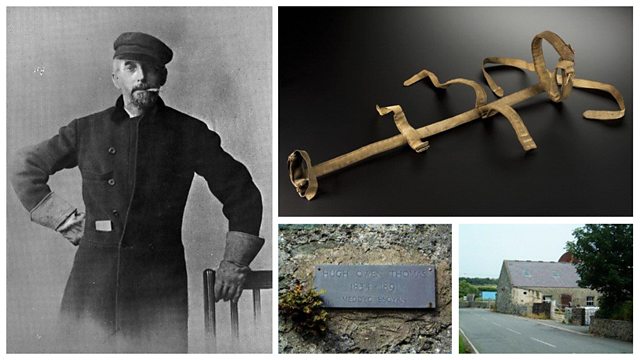
Tyn Llan Farm, Bodedern, Holyhead: The Anglesey Bone Setters and the Thomas Splint
Thousands survived WW1 battlefields thanks to the son of a bone setter from Anglesey and the Thomas Splint.
The Thomas Splint
Blast injuries on the battlefields of the First World War commonly resulted in broken limbs, and at the beginning of the war as many as 80% of those who suffered compound fractures of the femur would die of their wounds. However in 1916 a new treatment was introduced, the Thomas Splint, and by the end of the war this death rate had dropped to 7.3%. Thousands survived thanks to treatments introduced by the son of a bone setter from Anglesey, Hugh Owen Thomas.
The Thomas Splint applies tension to the injured limb and pulls it straight. An unattended fracture can increase bleeding and pain and also increases the body’s general response to the injury called the ‘metabolic response to the trauma’. The splint stabilises the fractured bones which cuts down on bleeding and reduces pain and the general effect of the fracture on the body.
History of ‘The Anglesey Bone Setters’:
Although formally trained in medicine himself, Hugh Owen Thomas came from a long line of folk medicine practitioners from Anglesey known as ‘The Anglesey Bone Setters’.
Evan Thomas was the first of the family of ‘bone setters’ to arrive in Anglesey. Evan arrived by shipwreck as a young boy in the mid-18th century. He was one of only two survivors, today believed to have been of Eastern European origin.
Brought up by the local doctor who gave him his name, Evan Thomas soon showed signs that he had skills in healing injured animals, which led on to him treating locals in the community. This practice of bone setting continued down through the generations of Evan Thomas’ family.
Evan’s grandson of the same name set up home and surgery in Liverpool, but over time hostilities from the medical profession developed towards him, which most likely influenced the guidance he gave his own children concerning recognised medical training.
All seven of the fourth generation of the bone setters went on to become doctors, Hugh Owen Thomas was amongst these siblings. Hugh was born in Tyn Llan, Anglesey on the 23rd of August 1834. Tyn Llan is now a farm outbuilding and has a plaque commemorating the birth place of Hugh Owen Thomas.
As a child Hugh suffered with his health and spent much of his childhood in Anglesey with his grandparents, the air there was considered better for him than that of Liverpool. After leaving school Hugh had an apprenticeship with his uncle in St. Asaph before attending University in Edinburgh when he was 21, and then going on to University College Hospital in London.
Hugh Owen Thomas later acquired 11 Nelson Street, Liverpool where he practised for the rest of his life. It was there that the Thomas splint was invented.
The Thomas Splint and World War One:
Robert Jones originally from Rhyl, was the nephew of Hugh Owen Thomas. Hugh’s nephew came to live with him in Liverpool where he served an apprenticeship with his uncle at Nelson Street.
During World War One, Robert Jones utilised the Thomas Splint on the Western Front. The work of his uncle was now fully recognised and appreciated, although not within Hugh’s lifetime. The effect of using the Thomas Splint was astounding as mortality of compound fractures of the femur fell from 80% to 7.3% between 1916 and 1918.
Location: Tyn Llan Farm, Bodedern, Holyhead, Isle of Anglesey LL653UD
Images: Tyn Llan in Bodedern, Anglesey.
Hugh Owen Thomas, courtesy of Wellcome Images
Thomas-type splint, courtesy of Wellcome Images
Video: Eddie Butler looks at the development of the Thomas splint
Duration:
This clip is from
Featured in...
![]()
Video & Footage
Clips from programmes, WW1 footage & slideshows
![]()
Pioneers—World War One At 91�ȱ�
The brains behind the breakthroughs
![]()
91�ȱ� Radio Wales—World War One At 91�ȱ�
Places in Wales that tell a story of World War One
![]()
Medicine—World War One At 91�ȱ�
Hospitals, medical pioneers and the nursing contribution
More clips from World War One At 91�ȱ�
-
![]()
The loss of HMY Iolaire
Duration: 18:52
-
![]()
Scotland, Slamannan and the Argylls
Duration: 07:55
-
![]()
Scotland Museum of Edinburgh mourning dress
Duration: 06:17
-
![]()
Scotland Montrose 'GI Brides'
Duration: 06:41







